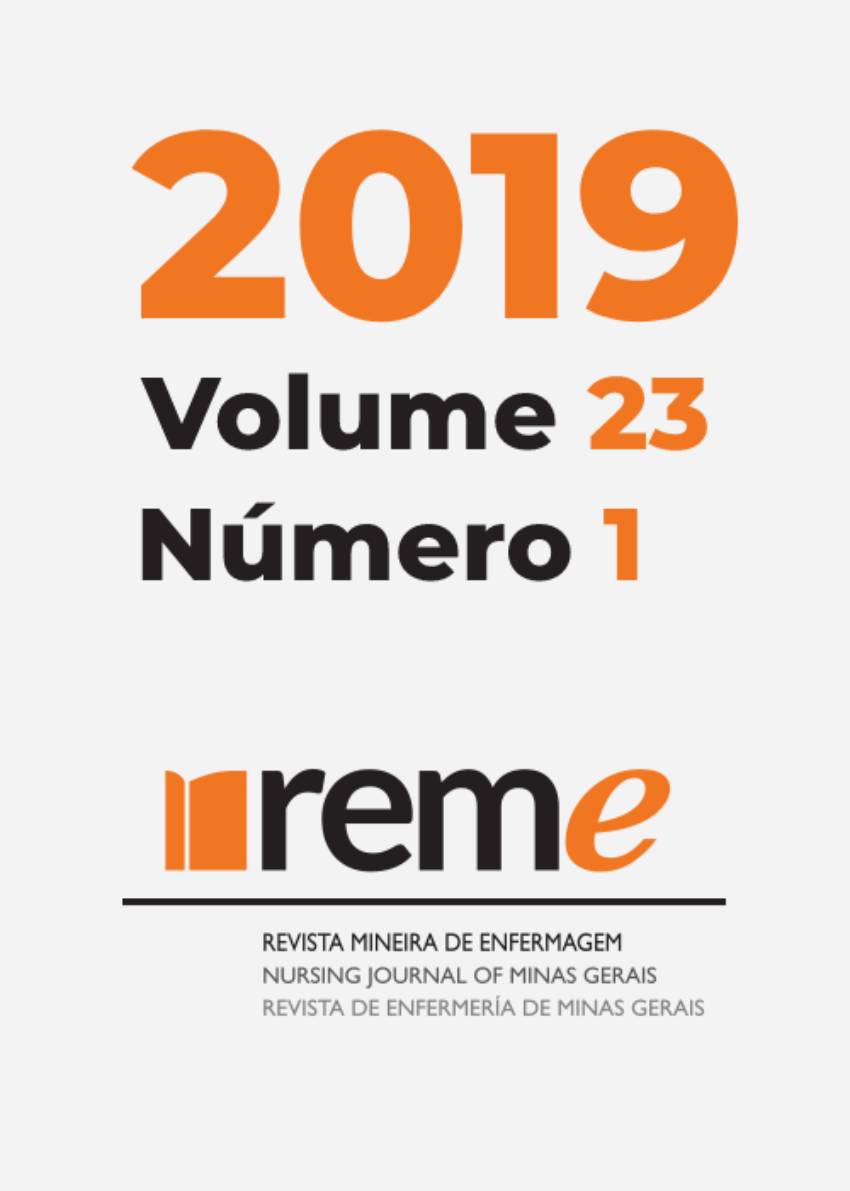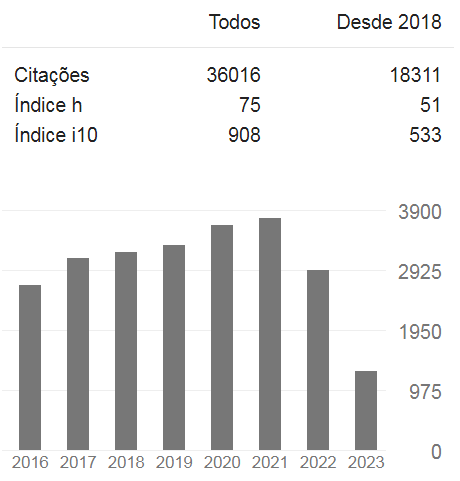Identification of factors that alter axillary temperature reliability in relation to pulmonary artery catheter temperature
DOI:
https://doi.org/10.5935/1415-2762.20190115Keywords:
Axilla, Thermometers, Pulmonary Artery, Body TemperatureAbstract
Objectives: to identify factors that alter the reliability of axillary temperature in relation to pulmonary artery catheter temperature. Methods: studying repeated
measures using 67 axillary temperature measurements collected from 24 patients admitted to intensive care centers of two hospitals in the metropolitan region of
Belo Horizonte between 2017 and 2018. Descriptive analysis and linear regression of the data were performed. Results: accuracy of 0.48 and precision of 0.47 were found for axillary temperature measured with a digital thermometer compared with pulmonary artery catheter temperature. Factors that change the reliability of axillary temperature were body mass index and dobutamine dose. Conclusion: the found factors were unprecedented in relation to the change in axillary temperature reliability and may help nurses in their decision making by choosing a more accurate method to estimate the actual body temperature. Studies with larger sampling are still necessary to evaluate the intervening factors of the reliability of noninvasive temperature techniques, such as axillary temperature.
References
Niven DS, Gaudet JE, Laupland KB, Mrklas KJ, Roberts DJ, Stelfox HT. Accuracy of peripheral thermometers for estimating temperature: a systematic review and meta-analysis. Ann Intern Med. 2015[citado em 2019 fev. 18];163:768-77. Disponível em: https://doi.org/10.7326/M15-1150
Hooper VD, Chard R, Theresa C, Fetzer S, Fossum S, Godden B, et al. ASPAN’s Evidence-Based Clinical Practice Guideline for the Promotion of Perioperative Normothermia. J Perianesth Nurs. 2009[citado em 2019 jan. 20];24(5):271-87. Disponível em: http://www.or.org/files/ASPAN%20Temp%20Guidelines.pdf
Schenone AL, Cohen A, Patarroyo G, Harper L, Wang X, Shishehbor MH, et al. Therapeutic hypothermia after cardiac arrest: a systematic review/meta-analysis exploring the impact of expanded criteria and targeted temperature. Resuscitation. 2016[citado em 2019 fev. 18];108:102-10. Disponível em: https://doi.org/10.1016/j.resuscitation.2016.07.238
Niven DJ, Laupland KB, Tabah A, Vesin A, Rello J, Koulenti D, et al. Diagnosis and management of temperature abnormality in ICUs: a EUROBACT investigators’ survey. Crit Care. 2013[citado em 2019 fev. 18];17:R289. Disponível em: https://dx.doi.org/10.1186%2Fcc13153
Wilson M, Penna AD. Targeted temperature modulation in the neuroscience patient. Crit Care Nurs Clin N Am. 2016[citado em 2019 jan. 20];28:125-36. Disponível em: https://doi.org/10.1016/j.cnc.2015.10.006
Emergency Nurses Association. Clinical practice guideline: non-invasivetemperature measurement. Des Plaines (United States): Emergency Nurses Association; 2015.
Crocetti M, Sabath B, Cranmer L, Gubser S, Dooley D. Knowledge and management of fever among latino parents. Clin Pediatr (Phila). 2009[citado em 2019 fev. 18];48(2):183-9. Disponível em: https://doi.org/10.1177/0009922808324949
Lawson L, Bridges EJ, Ballou I, Eraker R, Greco S, Shively J, et al. Accuracy and precision of noninvasive temperature measurement in adult intensive care patients. Am J Crit Care. 2007[citado em 2019 fev. 18];16(5):485-96. Disponível em: http://ajcc.aacnjournals.org/content/16/5/485.long
Rubia-Rubia J, Arias A, Sierra A, Aguirre-Jaime A. Measurement of body temperature in adult patients: comparative study of accuracy, reliability and validity of different devices. Int J Nurs Stud. 2011[citado em 2019 fev. 18];48:872-80. Disponível em: https://doi.org/10.1016/j.ijnurstu.2010.11.003
Moran JL, Peter JV, Solomon PJ, Grealy B, Smith T, Ashforth W, et al. Tympanic temperature measurements: are they reliable in the critically ill? A clinical study of measures of agreement. Crit Care Med. 2007[citado em 2019 mar. 02];35(1):155-64. Disponível em: https://doi.org/10.1097/01.CCM.0000250318.31453.CB
Polit DF, Beck CT, Hungler BP. Fundamentos de pesquisa em Enfermagem: avaliação de evidência para a prática da Enfermagem. 6ª ed. Porto Alegre: Artmed; 2011.
World Health Organization (WHO). Ebola surveillance in countries with no reported cases of Ebola virus disease. Geneva: WHO; 2014.
Bougouina W, Cariou A. Management of postcardiac arrest myocardial dysfunction. Curr Opin Crit Care. 2013[citado em 2019 fev. 18];19(3):195-201. Disponível em: https://doi.org/10.1097/MCC.0b013e3283607740
Mrozek S, Srairi M, Marhar F, Delmas C, Gaussiat F, Abaziou T. Successful treatment of inverted Takotsubo cardiomyopathy after severe traumatic brain injury with milrinone after dobutamine failure. Heart Lung. 2016[citado em 2019 fev. 18];45:406-8. Disponível em: https://doi.org/10.1016/j.hrtlng.2016.06.007
Mutoh T, Mutoh T, Nakamura K, Sasaki K, Tatewaki Y, Ishikawa T, et al. Inotropic support against early brain injury improves cerebral hypoperfusion and outcomes in a murine model of subarachnoid hemorrhage. Brain Res Bull. 2017[citado em 2019 fev. 18];130:18-26. Disponível em: https://doi.org/10.1016/j.brainresbull.2016.12.009
Neumar RW, Shuster M, Callaway CW, Gent LM, Atkins DL, Bhanji F, et al. Part 1: executive summary: 2015 American Heart Association Guidelines Update for Cardiopulmonary Resuscitation and Emergency Cardiovascular Care. Circulation. 2015[citado em 2019 fev. 18];132(18). Disponível em: https://doi.org/10.1161/CIR.0000000000000252
Associação Brasileira para o Estudo da Obesidade e da Síndrome Metabólica. Diretrizes Brasileiras de Obesidade. 4ª ed. São Paulo (Brasil): ABESO; 2016.
Zhao Y, Li Z, Yang T, Wang M, Xi X. Is body mass index associated with outcomes of mechanically ventilated adult patients in intensive critical units? A systematic review and meta-analysis. Plos One. 2018[citado em 2019 fev. 18];13(6):e0198669. Disponível em: https://www.ncbi.nlm.nih.gov/pubmed/29883469
Ministério da Saúde (BR). Febre Amarela: Guia para Profissionais de Saúde. Brasília: MS; 2017.
Downloads
Published
Issue
Section
License
Copyright (c) 2020 Reme: Revista Mineira de Enfermagem

This work is licensed under a Creative Commons Attribution 4.0 International License.






































